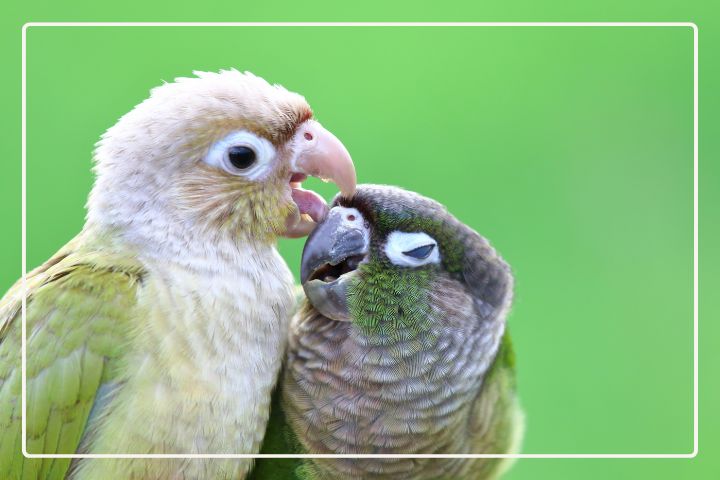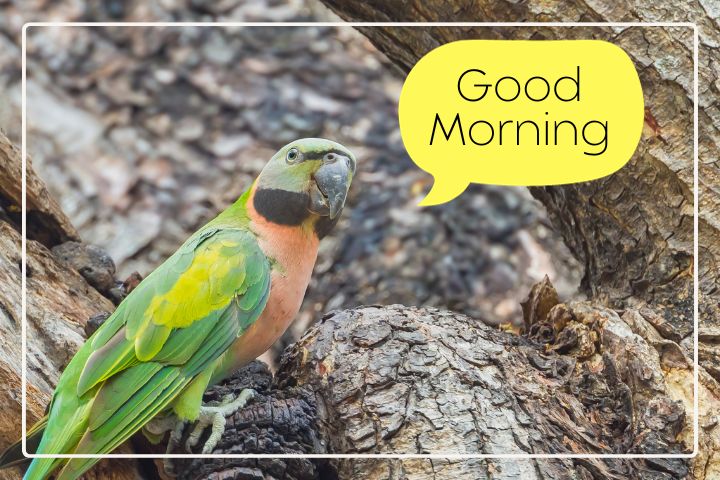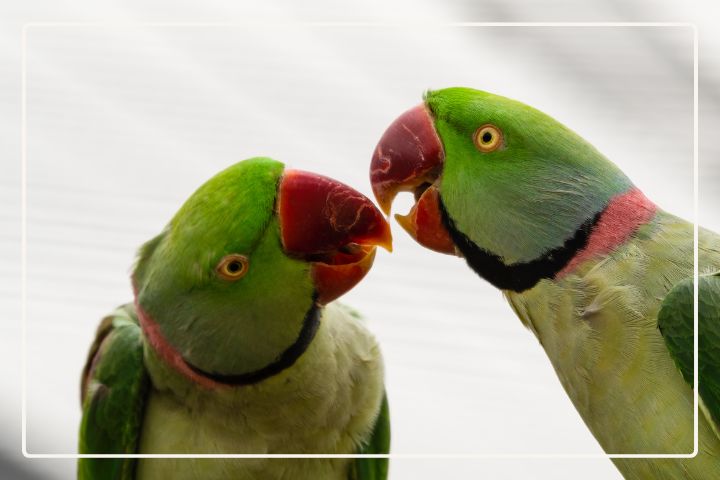Can Indian Ringnecks Live With Other Birds?
Indian Ringnecks are often kept as pets, and many bird enthusiasts wonder whether they can live with other birds. The answer is: it depends.
Indian Ringnecks can live peacefully with other birds, but it is important to do your research beforehand and introduce them slowly and carefully. Some of the most common birds that Indian Ringnecks are compatible with are: budgies, cockatiels, lovebirds, and conures. However, it is important to note that each bird has its own personality, and not all Indian Ringnecks will get along with other birds.
Understanding Indian Ringnecks and their compatibility with other birds is important for any bird owner. In this article, we will explore the factors that determine whether Indian Ringnecks can live with other birds, as well as potential issues and solutions. We will also discuss cage considerations, behavioral traits, and bonding. Finally, we will answer some frequently asked questions about Indian Ringnecks and other birds.
Key Takeaways
- Indian Ringnecks can live with other birds, but it is important to introduce them slowly and carefully.
- Each bird has its own personality, and not all Indian Ringnecks will get along with other birds.
- Understanding cage considerations, behavioral traits, and bonding is important for any bird owner.
Compatibility of Indian Ringnecks with Other Birds
Indian Ringnecks are social birds and can get along with other bird species, but it is important to introduce them slowly and carefully. Some of the most common birds that Indian Ringnecks are compatible with are budgies, cockatiels, lovebirds, and conures. However, it is important to note that individual personalities and temperaments vary, so compatibility cannot be guaranteed.
Indian Ringnecks and Cockatiels
Many people wonder if Indian Ringnecks and Cockatiels can be friends and live together. While it is possible for these two species to get along, it is important to monitor their interactions closely. Indian Ringnecks are larger and more dominant than Cockatiels, so it is important to ensure that the Cockatiel is not being bullied or intimidated by the Indian Ringneck.
Introducing Birds
When introducing birds to each other, it is important to keep them at a distance and monitor them for signs of aggression. Signs of aggression may include biting, hissing, or puffing up their feathers. If any signs of aggression are present, it is best to separate the birds and try again at a later time.
Compatibility Chart
Here is a chart that shows the compatibility of Indian Ringnecks with other bird species:
| Bird Species | Compatibility with Indian Ringnecks |
|---|---|
| Budgies | Good |
| Cockatiels | Fair |
| Lovebirds | Good |
| Conures | Good |
It is important to note that this chart is a general guideline and that individual personalities and temperaments vary, so compatibility cannot be guaranteed.
Potential Issues and Solutions
When introducing Indian Ringnecks to other bird species, there are potential issues that may arise. It is important to be aware of these issues and take necessary precautions to ensure the safety and well-being of all birds involved.
Aggression
Indian Ringnecks can get aggressive towards other birds, especially if they feel threatened or if their space is invaded. They may even kill other birds if they feel like their territory is being threatened. It is important to supervise the birds when putting them together and to separate them immediately if any aggression occurs.
Neurotic Behavior
Indian Ringnecks can get neurotic if they are not given enough attention or if they are kept in a small space. This can lead to behavioral problems such as feather plucking or screaming. It is important to provide them with enough space and attention to keep them happy and healthy.
Fundamental Differences
There are fundamental differences between Indian Ringnecks and other bird species that may cause issues when they are put together. For example, Indian Ringnecks have specific dietary requirements that other birds may not be able to meet. It is important to research the dietary needs of all birds involved and provide them with appropriate food.
Solutions
To avoid potential issues, it is important to introduce the birds slowly and carefully. Begin by placing their cages near each other so they can get used to each other’s presence. Once they seem comfortable, allow them to interact under close supervision. If any aggression occurs, separate them immediately.
Providing enough space for all birds is also important. A large enough cage or aviary should be provided to allow them to move around freely. Additionally, providing toys and perches can help keep them happy and entertained.
Cage Considerations
When considering whether Indian Ringnecks can live with other birds, it is important to take into account the cage size and design. Indian Ringnecks are social creatures and need plenty of attention, so they should not be the only bird in the household. They also like to climb and explore, so their cage should be spacious and have plenty of toys and perches.
Ideally, it would be best for each specie to have their own cages. This will help prevent any territorial disputes and ensure that all birds have access to food and water.
With that said, it is possible for Indian Ringnecks to share a cage with other birds, but it is important to make sure that the cage is large enough for all birds to have their own space. If the birds are not compatible, it is best to separate them into their own cages.
When introducing Indian Ringnecks to other birds, it is important to do so gradually and with caution. The birds should be kept in separate cages at first, and allowed to interact under close supervision. If there are any signs of aggression or discomfort, the birds should be separated immediately.
Behavioral Traits and Bonding
Indian Ringnecks are known for their social nature and their ability to bond with their owners. They are intelligent and playful birds that enjoy interacting with their owners. Ringnecks generally get along well with other birds, especially birds of similar size and temperament.
When introducing two birds, it is important to keep in mind the size and temperament of each bird. Smaller birds may be intimidated by larger birds, which can lead to aggression. Similarly, birds with aggressive or dominant personalities may not be the best choice to keep with a more timid bird.
Ringnecks can form strong bonds with their owners, often choosing a favorite person to spend time with. They enjoy perching on their favorite person’s shoulder and may even cuddle up for a nap.
In a flock or aviary setting, Ringnecks enjoy playing with toys and foraging for food. Providing plenty of toys and opportunities for foraging can help stimulate their minds and keep them entertained. They also enjoy socializing with other birds and will often engage in playful behavior like tossing toys or playing with each other’s beaks.
Frequently Asked Questions
Do Indian Ringnecks Need Companions?
Indian Ringnecks are social birds and enjoy the company of other birds, but they can also be happy as a single bird if they receive enough attention from their owner.
Are Ringnecks Aggressive To Other Birds?
Indian Ringnecks can be aggressive towards other birds if they feel threatened or if they are not properly introduced. It is important to introduce them slowly and carefully to other birds to avoid any aggression.
Will my Indian Ringneck get along with another bird?
There is no guarantee that an Indian Ringneck will get along with another bird, as individual personalities and compatibility play a significant role. Proper introductions and monitoring are key to their successful cohabitation.
What Birds Can be Kept with Indian Ringnecks?
Indian Ringnecks can live peacefully with other birds, but it is important to do your research beforehand and introduce them slowly and carefully. Some birds that can be kept with Indian Ringnecks include conures, cockatiels, and budgies.
Can I keep two Indian Ringnecks together?
Yes, Indian Ringnecks can be kept together as long as they have enough space and resources to establish their own territories.
Do Indian Ringnecks Get Along With Budgies?
Indian Ringnecks can get along with budgies as long as they are initially kept in separate cages with plenty of space. It is important to introduce the birds slowly and carefully.
Do Ringnecks Get Along With Cockatiels?
As long as Indian Ringnecks and cockatiels are first kept in separate cages with ample room, they can coexist. The gradual and cautious introduction of the birds is crucial.
Do Indian Ringnecks Get Along With Conures?
Indian Ringnecks and conures can coexist as long as they are initially housed in separate enclosures with ample room. It is crucial to introduce the avian companions gradually and cautiously.
Do Quakers and Ringnecks get along?
Indian Ringnecks and Quakers can have a harmonious relationship if they are initially housed in separate enclosures with ample room. It is crucial to gradually and cautiously introduce the two birds to one another.
Can I keep Indian Ringnecks together with a Macaw?
It is generally not recommended to keep Indian Ringnecks with larger parrots like Macaws due to the size difference and potential for aggression.
Can I keep Indian Ringnecks and Lovebirds in the same cage?
Indian Ringnecks and Lovebirds have different temperaments and housing requirements, so it is not advisable to keep them together in the same cage.
Can Indian Ringnecks live together with an Alexandrine?
Indian Ringnecks and Alexandrines are both parrot species, and with proper introduction and supervision, they can potentially live together in harmony.
Can Indian Ringnecks be kept with a Cockatoo?
It is generally not recommended to keep Indian Ringnecks with Cockatoos as they have different social needs and temperaments.
Can Indian Ringnecks live with other large parrots?
Indian Ringnecks can coexist with other large parrots but not in the same cage.
What should I do if I want to keep Indian Ringnecks and other birds together in the same cage?
If you wish to keep Indian Ringnecks and other birds together, it is best to consult with a bird behaviorist or avian veterinarian for guidance on proper introductions and ongoing management.
Read our article on the Overview, Characteristics and Care of Indian Ringneck Parakeets
Conclusion
The question of whether Indian Ringnecks can live with other birds is a complex one. While some sources suggest that it is possible under certain circumstances, others caution against it due to their territorial nature. Ultimately, it will depend on the individual birds and their personalities.
It is important to consider the size and age of the birds when introducing them to each other. Larger birds may intimidate smaller birds, which can lead to aggression. Young birds are more likely to be accepting of other birds compared to older birds. Indian Ringnecks also have specific dietary requirements that other birds may not be able to meet.
While Indian Ringnecks are social creatures and enjoy attention, they should not be the only bird in the household. They also like to climb and explore, so their cage should be spacious and have plenty of toys and perches. It is important to monitor the birds closely when introducing them and to separate them if any signs of aggression arise.
In general, it is crucial to thoroughly evaluate the specific birds and their requirements prior to making the decision to cohabitate Indian Ringnecks with other bird species. By creating an appropriate habitat and closely observing their interactions, it might be feasible for Indian Ringnecks to coexist peacefully with other avian companions.








Rattling fantastic info can be found on site.